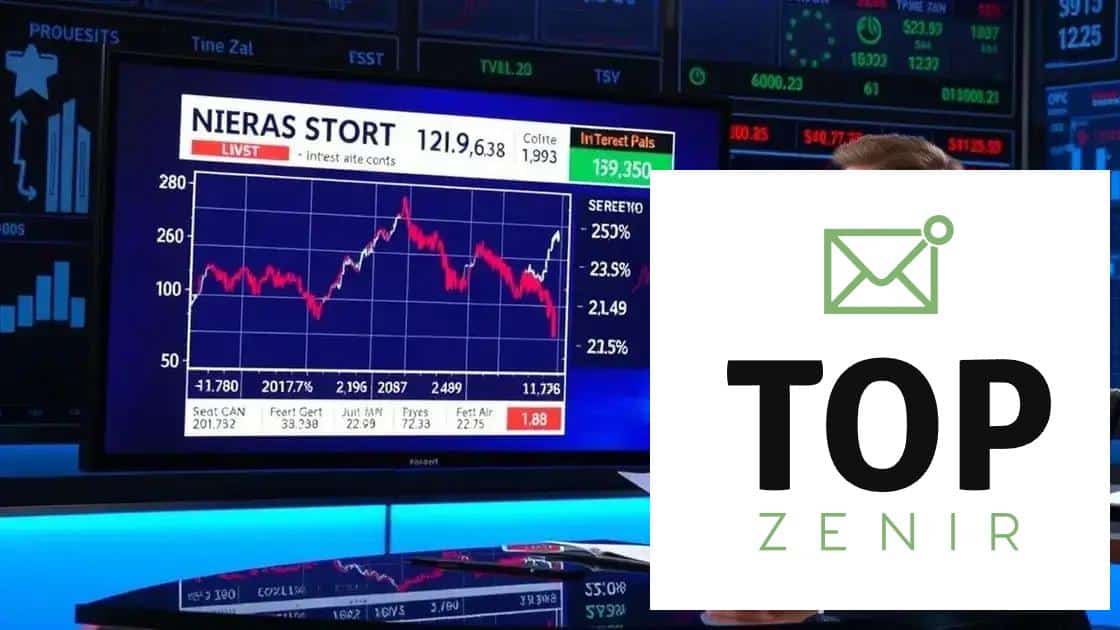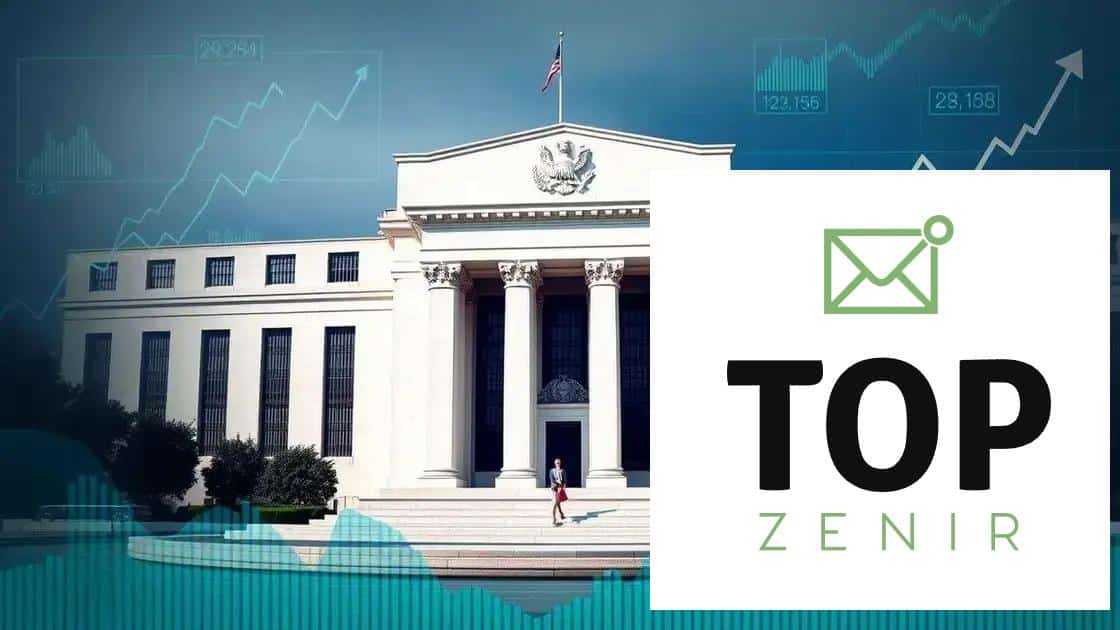Federal Reserve hints at upcoming rate changes

The Federal Reserve hints at upcoming rate changes to manage inflation and support economic stability, impacting consumer borrowing costs and business investments significantly.
Federal Reserve hints at upcoming rate changes are creating a buzz in the financial world. Have you considered how these adjustments might affect your finances and investments? Let’s dive in and explore the details.
Current economic indicators and their implications
Understanding the current economic indicators is crucial for anyone following the market trends. These indicators provide valuable insights into the economic health of a nation, guiding both policymakers and consumers. In this section, we will examine some key indicators and their implications.
Key Economic Indicators
The main indicators include GDP growth, unemployment rates, and inflation. Each of these indicators tells a different part of the economic story.
- Gross Domestic Product (GDP): This measures the total value of goods and services produced. A higher GDP often indicates a growing economy.
- Unemployment Rate: This reflects the percentage of the labor force that is unemployed and actively seeking work. A lower rate generally suggests a healthier economy.
- Inflation Rate: This shows the rate at which prices for goods and services rise. High inflation can erode purchasing power.
As the Federal Reserve reviews these indicators, they can decide on necessary adjustments to interest rates. For example, if inflation is rising too quickly, a rate increase might be implemented to cool off spending. Conversely, if GDP growth is sluggish, lowering rates could promote borrowing and spending, stimulating the economy.
Understanding Their Implications
Recognizing how these indicators interact can help predict economic trends. For instance, if unemployment is decreasing but inflation is rising, it might signal an overheating economy. This can lead to the Fed considering rate changes sooner rather than later.
Moreover, shifts in these indicators can impact consumer behavior. During times of high inflation, people might reduce spending, impacting businesses. On the other hand, lower interest rates can encourage investments and spending, which can positively affect economic growth.
Potential rate changes: what to expect

When discussing potential rate changes, it’s important to understand the context and the factors that might influence these decisions. The Federal Reserve carefully watches various economic indicators before making any adjustments to interest rates.
Factors Influencing Rate Changes
Several elements can impact the decision on whether to raise or lower rates. Key considerations include inflation trends, employment data, and overall economic growth.
- Inflation Levels: If inflation rises above the Fed’s target, they may increase rates to help stabilize prices.
- Employment Rates: A high employment rate can signal a strong economy, potentially leading to higher rates.
- Consumer Spending: If spending decreases, the Fed might consider lowering rates to encourage borrowing and boost economic activity.
As the Fed evaluates these factors, investors and consumers alike should remain alert to the signs of impending rate changes. These adjustments can have a ripple effect throughout the economy, impacting everything from mortgage rates to credit card interest rates.
What Could Happen Next?
Looking ahead, if economic growth stays robust, we may see the Fed opting for gradual rate increases. This approach is typically aimed at preventing the economy from overheating while ensuring that inflation remains in check. Conversely, if signs of an economic slowdown appear, a reduction in rates could be on the table to stimulate growth.
Staying informed about the Fed’s decisions can help individuals and businesses make better financial choices. Understanding the potential for rate changes will allow people to plan their investments and expenses more effectively.
Impact of rate changes on consumers and businesses
The impact of rate changes on both consumers and businesses can be significant and multifaceted. When the Federal Reserve adjusts interest rates, it leads to a chain reaction affecting various aspects of the economy. Understanding these effects is vital for making informed financial decisions.
Effects on Consumers
For consumers, interest rate changes directly influence borrowing costs. A rise in rates means higher loan and credit card interest payments. This can lead to reduced spending power, as more of a household’s budget goes toward interest payments.
- Mortgage Rates: Higher rates can increase monthly mortgage payments, making home buying more expensive.
- Credit Card Rates: Many credit cards have variable rates, meaning higher rates can increase monthly repayments.
- Car Loans: Higher interest rates can affect financing options for buying new or used vehicles.
As consumers feel the squeeze from higher borrowing costs, they might cut back on discretionary spending. This reduction in spending can slow down economic growth.
Effects on Businesses
Businesses are also impacted significantly by rate changes. When rates rise, the cost of borrowing increases for firms, affecting their investment decisions. Companies might postpone expansion plans or reduce hiring due to higher loan costs.
- Capital Investments: Higher rates can deter businesses from taking out loans for new projects or equipment.
- Cash Flow: Increased interest expenses can reduce cash flow, limiting operational flexibility.
- Consumer Demand: As consumer spending decreases, businesses may see lower sales and revenue growth.
In contrast, lower interest rates can stimulate borrowing and investment, encouraging both consumer spending and business growth. This dynamic shows how interconnected the economy is; changes in interest rates can ripple through various channels, influencing behaviors and decisions at both the personal and corporate levels.
Federal Reserve policies: understanding the broader context

To grasp the Federal Reserve policies, it is essential to consider the broader economic context. These policies are designed not only to manage inflation but also to support employment and foster a stable economic environment.
Role of the Federal Reserve
The Federal Reserve, often referred to as the Fed, influences the economy primarily through monetary policy. By adjusting interest rates and controlling the money supply, the Fed aims to promote maximum employment and stable prices.
- Monetary Policy Tools: The Fed uses several tools, such as the federal funds rate, open market operations, and reserve requirements.
- Targeting Inflation: They typically aim for a 2% inflation rate as a sign of a stable economy.
- Supporting Employment: Policies are also focused on reducing unemployment by encouraging borrowing and spending.
Understanding these tools helps illustrate how the Fed reacts to changes in the economy. For instance, during economic downturns, the Fed might lower interest rates to stimulate borrowing and investment.
Impact on the Economy
The Fed’s actions have widespread implications. When the Fed raises interest rates, for example, borrowing becomes more expensive. This may lead to decreased consumer spending and slower business investment. Conversely, lowering rates can spark economic growth by making loans cheaper.
External factors like global economic conditions, trade policies, and domestic events also play a role. For example, events like financial crises or pandemics can force the Fed to adapt its strategies quickly. As a result, staying informed about these policies helps you understand the economic landscape better.
In summary, the Federal Reserve policies are deeply interwoven with various economic factors, and recognizing their context will empower consumers and businesses to make informed decisions.
Expert opinions on anticipated shifts
Exploring expert opinions on anticipated shifts in monetary policy provides valuable insights into future economic trends. Financial analysts and economists closely monitor the Federal Reserve‘s actions and the broader economic context to make predictions about upcoming changes.
Current Economic Climate
Many experts are currently evaluating how recent inflation reports and employment data will influence the Fed’s decisions. For instance, if inflation continues to exceed expectations, many analysts anticipate that the Fed will raise interest rates sooner rather than later.
- Market Reactions: Experts note that financial markets typically react swiftly to Fed announcements, emphasizing the importance of clear communication from the Fed.
- Global Influences: Global economic conditions, such as trade tensions or geopolitical events, can also sway Fed policies, and experts are keen to analyze these factors.
- Investment Strategies: Investors often adapt their strategies based on expert forecasts, looking for potential shifts in interest rates.
Another point of discussion among experts is the potential for the Fed to adopt a more cautious approach if economic indicators paint a mixed picture. For example, if employment rates drop but inflation remains high, the Fed might choose to hold rates steady while continuing to assess the situation.
Seeking Diverse Viewpoints
Listening to a range of expert opinions can help individuals and businesses prepare for the potential impact of these shifts. Some economists advocate for a more aggressive approach, while others recommend patience to allow economic growth to stabilize.
Ultimately, understanding the nuances in these discussions equips consumers and businesses to navigate uncertain financial times better. Staying informed about expert predictions will help you adjust your financial plans as needed.
In conclusion, understanding the Federal Reserve’s policies and their anticipated impacts is essential for navigating the economy effectively. By keeping an eye on economic indicators, expert opinions, and potential rate changes, both consumers and businesses can make informed decisions. Awareness of these elements can empower you to adapt to fluctuations in the financial landscape, ensuring your strategies align with current trends. Staying updated will help you position yourself better, whether you are planning personal finances or running a business.
FAQ – Frequently Asked Questions about Federal Reserve Policies
What are the main responsibilities of the Federal Reserve?
The Federal Reserve manages monetary policy, regulates banks, and provides financial services to ensure stability in the economy.
How do rate changes affect consumer loans?
When rates increase, the cost of borrowing rises, leading to higher monthly payments for loans such as mortgages and car loans.
Why is it important to follow expert opinions on rate changes?
Expert opinions can provide valuable insights into how future rate changes may impact the economy and help individuals and businesses plan accordingly.
What should consumers do when they anticipate rate changes?
Consumers should evaluate their financial plans, consider locking in lower rates for loans, and stay informed about economic trends.





